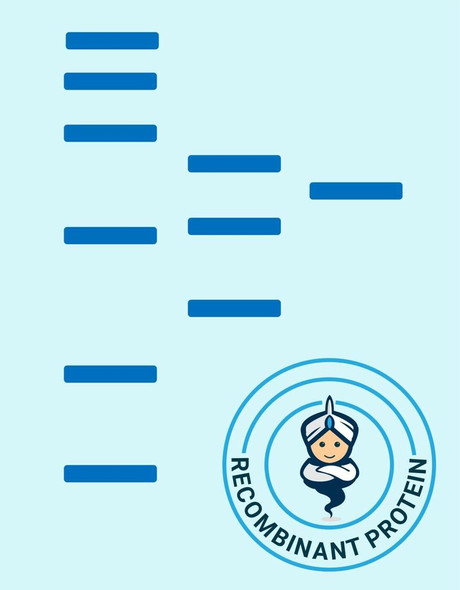Description
| Product Name: | Human DLX3 Recombinant Protein |
| Product Code: | RPPB3363 |
| Size: | 20µg |
| Species: | Human |
| Target: | DLX3 |
| Synonyms: | Homeobox protein DLX-3, DLX3, Distal-Less Homeobox 3, AI4, TDO. |
| Source: | Escherichia Coli |
| Physical Appearance: | Sterile filtered colorless solution. |
| Formulation: | DLX3 protein solution (1mg/ml) containing 20mM Tris-HCl buffer (pH8.0) and 10% glycerol. |
| Stability: | Store at 4°C if entire vial will be used within 2-4 weeks. Store, frozen at -20°C for longer periods of time. For long term storage it is recommended to add a carrier protein (0.1% HSA or BSA).Avoid multiple freeze-thaw cycles. |
| Purity: | Greater than 90% as determined by SDS-PAGE. |
| Amino Acid Sequence: | MGSSHHHHHH SSGLVPRGSH MGSMSGSFDR KLSSILTDIS SSLSCHAGSK DSPTLPESSV TDLGYYSAPQ HDYYSGQPYG QTVNPYTYHH QFNLNGLAGT GAYSPKSEYT YGASYRQYGA YREQPLPAQD PVSVKEEPEA EVRMVNGKPK KVRKPRTIYS SYQLAALQRR FQKAQYLALP ERAELAAQLG LTQTQVKIWF QNRRSKFKK |
DLX3 belongs to the Distal-less (Dlx) family of genes which includes at least 6 different members. DLX3 plays a regulatory role in the development of the ventral forebrain and also in craniofacial patterning and morphogenesis. Mutation in DLX3 is correlated with Trichodentoosseous syndrome which is an autosomal dominant condition. DLX3 is located in a tail-to-tail configuration with another member of the gene family on the long arm of chromosome 17.
DLX3 Human Recombinant produced in E.Coli is a single, non-glycosylated polypeptide chain containing 209 amino acids (1-186 a.a) and having a molecular mass of 23.4kDa.DLX3 is fused to a 23 amino acid His-tag at N-terminus & purified by proprietary chromatographic techniques.
| UniProt Protein Function: | DLX3: Likely to play a regulatory role in the development of the ventral forebrain. May play a role in craniofacial patterning and morphogenesis. Defects in DLX3 are a cause of trichodentoosseous syndrome (TDO). TDO is an autosomal dominant syndrome characterized by enamel hypoplasia and hypocalcification with associated strikingly curly hair. Defects in DLX3 are the cause of amelogenesis imperfecta type 4 (AI4); also known as amelogenesis imperfecta hypomaturation-hypoplastic type with taurodontism. AI4 is an autosomal dominant defect of enamel formation associated with enlarged pulp chambers. Belongs to the distal-less homeobox family. |
| UniProt Protein Details: | Protein type:DNA-binding; Transcription factor Chromosomal Location of Human Ortholog: 17q21.33 Molecular Function:transcription factor activity Disease: Amelogenesis Imperfecta, Type Iv; Trichodentoosseous Syndrome |
| NCBI Summary: | Many vertebrate homeo box-containing genes have been identified on the basis of their sequence similarity with Drosophila developmental genes. Members of the Dlx gene family contain a homeobox that is related to that of Distal-less (Dll), a gene expressed in the head and limbs of the developing fruit fly. The Distal-less (Dlx) family of genes comprises at least 6 different members, DLX1-DLX6. Trichodentoosseous syndrome (TDO), an autosomal dominant condition, has been correlated with DLX3 gene mutation. This gene is located in a tail-to-tail configuration with another member of the gene family on the long arm of chromosome 17. Mutations in this gene have been associated with the autosomal dominant conditions trichodentoosseous syndrome and amelogenesis imperfecta with taurodontism. [provided by RefSeq, Jul 2008] |
| UniProt Code: | O60479 |
| NCBI GenInfo Identifier: | 3913487 |
| NCBI Gene ID: | 1747 |
| NCBI Accession: | O60479.1 |
| UniProt Secondary Accession: | O60479,B3KQL6, |
| UniProt Related Accession: | O60479 |
| Molecular Weight: | 31,738 Da |
| NCBI Full Name: | Homeobox protein DLX-3 |
| NCBI Synonym Full Names: | distal-less homeobox 3 |
| NCBI Official Symbol: | DLX3�� |
| NCBI Official Synonym Symbols: | AI4; TDO�� |
| NCBI Protein Information: | homeobox protein DLX-3 |
| UniProt Protein Name: | Homeobox protein DLX-3 |
| Protein Family: | Distal-less-like protein |
| UniProt Gene Name: | DLX3�� |






